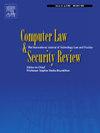A Comparative review of Symbolism and Connectionism in AI&Law: Tracing evolution and exploring integration
IF 3.2
3区 社会学
Q1 LAW
引用次数: 0
Abstract
AI&Law explores computational methods for automating legal reasoning and prediction, evolving in parallel with AI research and developing along two primary paths: symbolic and connectionist approaches. Symbolic AI&Law centers on the formal representation of legal concepts and performing reasoning based on statutes and case law. These methods have led to the development of rule-based and case-based reasoning systems, successfully implemented in legal expert systems. The primary advantage of symbolic approaches is their inherent explainability, although they face limitations due to the knowledge acquisition bottleneck. Connectionist AI&Law encourages legal professionals to adopt inductive inference and use “bottom-up” learning models to extract hidden features from large datasets. This paradigm incorporates machine learning and natural language processing (NLP) techniques to address legal information extraction, retrieval, text classification, summarization, and legal prediction tasks. The advent of large language models (LLMs) has further expanded the capabilities of connectionist models, enabling more sophisticated legal text analysis and predictive accuracy, though issues of model transparency and hallucination remain active areas of research. The interaction between symbolic and connectionist approaches can complement each other. Symbolic models can enhance the transparency and explainability of connectionist systems, while connectionist techniques can optimize the scalability and efficiency of symbolic reasoning processes. These two paradigms exhibit strong potential for collaboration, particularly in the domains of explainable dialogue systems, neuro-symbolic systems, legal knowledge embedding and legal argumentation mining, etc.
《人工智能与法律》中的象征主义与联结主义比较:追溯演变,探索融合
AI Law探索自动化法律推理和预测的计算方法,与AI研究并行发展,并沿着两条主要路径发展:符号和连接主义方法。符号法以法律概念的形式表现和基于成文法和判例法的推理为中心。这些方法导致了基于规则和基于案例的推理系统的发展,并成功地在法律专家系统中实施。符号方法的主要优点是其固有的可解释性,尽管它们面临着知识获取瓶颈的限制。Connectionist ai Law鼓励法律专业人士采用归纳推理,并使用“自下而上”的学习模型从大型数据集中提取隐藏特征。该范式结合了机器学习和自然语言处理(NLP)技术来解决法律信息提取、检索、文本分类、摘要和法律预测任务。大型语言模型(llm)的出现进一步扩展了连接主义模型的能力,使更复杂的法律文本分析和预测准确性成为可能,尽管模型透明度和幻觉问题仍然是研究的活跃领域。符号主义和联结主义研究方法之间的相互作用可以相互补充。符号模型可以增强连接主义系统的透明性和可解释性,而连接主义技术可以优化符号推理过程的可扩展性和效率。这两种范式在可解释对话系统、神经符号系统、法律知识嵌入和法律论证挖掘等领域表现出强大的合作潜力。
本文章由计算机程序翻译,如有差异,请以英文原文为准。
求助全文
约1分钟内获得全文
求助全文
来源期刊
CiteScore
5.60
自引率
10.30%
发文量
81
审稿时长
67 days
期刊介绍:
CLSR publishes refereed academic and practitioner papers on topics such as Web 2.0, IT security, Identity management, ID cards, RFID, interference with privacy, Internet law, telecoms regulation, online broadcasting, intellectual property, software law, e-commerce, outsourcing, data protection, EU policy, freedom of information, computer security and many other topics. In addition it provides a regular update on European Union developments, national news from more than 20 jurisdictions in both Europe and the Pacific Rim. It is looking for papers within the subject area that display good quality legal analysis and new lines of legal thought or policy development that go beyond mere description of the subject area, however accurate that may be.

 求助内容:
求助内容: 应助结果提醒方式:
应助结果提醒方式:


